2021 TOYOTA RAV4 PHEV pressure
[x] Cancel search: pressurePage 580 of 666

5788-2. Steps to take in an emergency
■Warning messages
The warning messages explained below
may differ from the actual messages according to operation conditions and
vehicle specifications.
■If a message about an operation is
shown
●If a message about an operation of
the accelerator pedal or brake pedal is shown
NOTICE
■To ensure the tire pressure warn -
ing system operates properly
Do not install tires with different speci - fications or manufacturers, as the tire
pressure warning system may not
operate properly.
If a warning message is
displayed
The multi-information display
shows warnings of system
malfunctions, incorrectly per -
formed operations, and mes -
sages that indicate a need for
maintenance. When a message
is shown, perform the correc -
tion procedure appropriate to
the message.
If a warning message is dis -
played again after the appropri -
ate actions have been performed,
contact any aut horized Toyota
retailer or Toyo ta authorized
repairer, or any reliable repairer.
When a message about charging
is displayed, refer to P.160.
Page 581 of 666

579
8
8-2. Steps to take in an emergency
When trouble arises
A warning message about an operation
of the brake pedal m ay be shown while
the driving suppor t systems such as
PCS (Pre-Collis ion system) (if
equipped) or the dynamic radar cruise
control with full- speed range (if
equipped) is operating. If a warning
message is shown, be sure to deceler -
ate the vehicle or follow an instruction
shown on the multi-in formation display.
• A warning message is shown when
Brake Override System operates. ( →P.301, 574)
• A warning message is shown when
Drive-Start Control or Parking Support Brake function (if equipped) operates
( →P.301, 420). Follow the instructions
on the multi-information display.
●If a message about an operation of
the power switch is shown
An instruction for operation of the power
switch is shown when the incorrect pro -
cedure for starting the hybrid system is
performed or the power switch is oper -
ated incorrectly. Follow the instructions
shown on the multi-in formation display
to operate the pow er switch again.
●If a message about a shift lever opera-
tion is shown
To prevent the shift lever from being
operated incorrectly or the vehicle from
moving unexpectedly, a message that
requires shifting the shift lever may be
shown on the multi-in formation display.
In that case, follow the instruction of the
message and shift the shift lever.
●If a message or image about an
open/close state of a part or replen-
ishment of a consumable is shown
Confirm the part indicated by the multi-
information display or a warning light,
and then perform the coping method
such as closing the open door or replen -
ishing a consumable.
■If a message that indicates the
need for visiting any authorized Toyota retailer or Toyota autho -
rized repairer, or any reliable
repairer is displayed
The system or part sh own on the multi-
information display is malfunctioning.
Have the vehicle inspected by any authorized Toyota r etailer or Toyota
authorized repairer, or any reliable
repairer immediately.
■If a message that indicates the need for referring to Owner’s Man -
ual is displayed
●If the following messages are shown,
follow the instructions, accordingly.
• “Blind Spot Monitor Unavailable” ( →P.394, 578)
• “RCTA Unavailable” ( →P.394, 578)
• “Engine Coolant Temp High” ( →P.611)
• “Exhaust Filter Full” ( →P.437)
●If the following messages are shown,
there may be a malfunction. Immedi -
ately stop the vehicle in a safe place and contact any authorized Toyota
retailer or Toyota authorized repairer,
or any reliable repairer. Continuing to drive the vehicle may be dangerous.
• “Plug-in charging system malfunction”
• “Hybrid System Malfunction” • “Charging System Malfunction”
• “Check Engine”
• “Hybrid Battery System Malfunction” • “Accelerator System Malfunction”
• “Smart Entry & Start System Malfunc -
tion”
●If the following messages are shown,
there may be a malfunction. Immedi - ately have the vehi cle inspected by
any authorized Toyota retailer or
Toyota authorized repairer, or any reli -
able repairer. • “Oil Pressure Low”
• “Braking Power Low”
●If any of the following messages are
shown on the multi-information dis -
play, the vehicle ma y have run out of fuel. Stop the vehicle in a safe place
and, if the fuel leve l is low, refuel the
Page 585 of 666
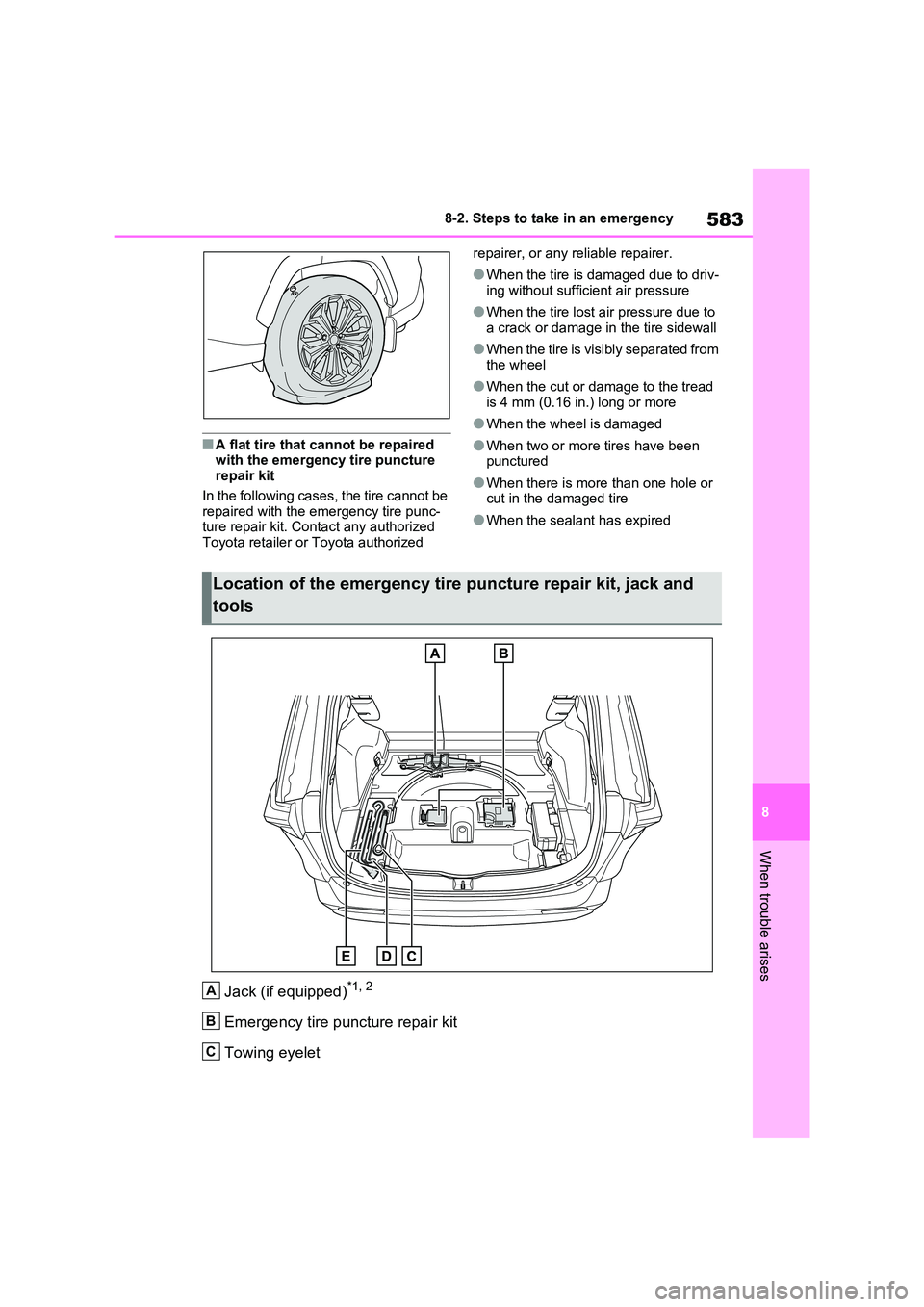
583
8
8-2. Steps to take in an emergency
When trouble arises
■A flat tire that c annot be repaired with the emergency tire puncture
repair kit
In the following cases, the tire cannot be repaired with the emergency tire punc -
ture repair kit. Con tact any authorized
Toyota retailer or Toyota authorized
repairer, or any reliable repairer.
●When the tire is damaged due to driv -
ing without sufficient air pressure
●When the tire lost a ir pressure due to
a crack or damage in the tire sidewall
●Whe n t he t ir e is v is ibl y se par a ted fr o m
the wheel
●When the cut or damage to the tread
is 4 mm (0.16 in .) long or more
●When the wheel is damaged
●When two or more tires have been punctured
●When there is more than one hole or cut in the damaged tire
●When the sealant has expired
Jack (if equipped)*1, 2
Emergency tire puncture repair kit
Towing eyelet
Location of the emergency tire puncture repair kit, jack and
tools
A
B
C
Page 586 of 666
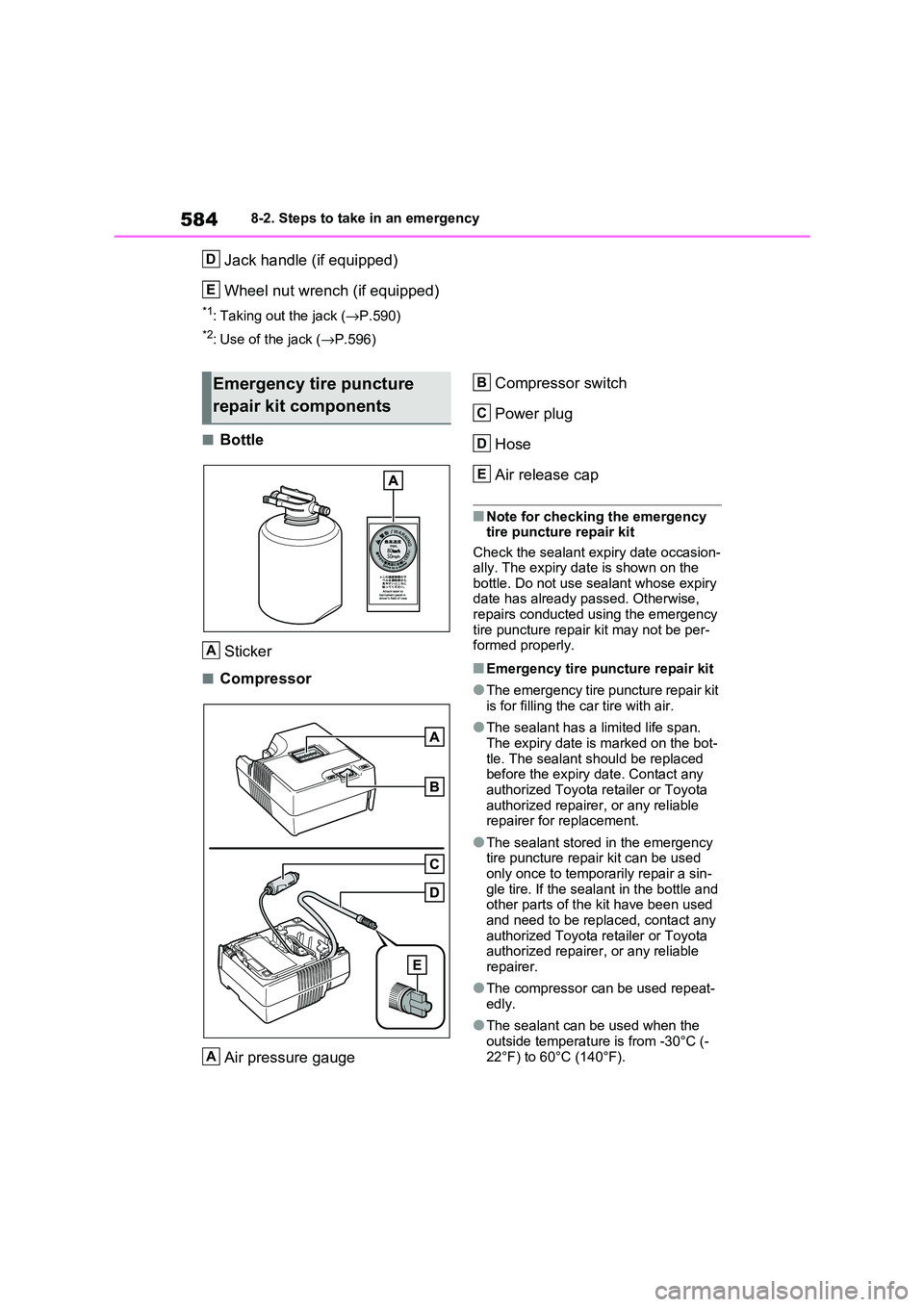
5848-2. Steps to take in an emergency
Jack handle (if equipped)
Wheel nut wrench (if equipped)
*1: Taking out the jack (→P.590)
*2: Use of the jack (→P.596)
■Bottle
Sticker
■Compressor
Air pressure gauge
Compressor switch
Power plug
Hose
Air release cap
■Note for checking the emergency tire puncture repair kit
Check the sealant e xpiry date occasion-
ally. The expiry date is shown on the bottle. Do not use sealant whose expiry
date has already passed. Otherwise,
repairs conducted using the emergency tire puncture repair kit may not be per -
formed properly.
■Emergency tire puncture repair kit
●The emergency tire puncture repair kit
is for filling the car tire with air.
●The sealant has a limited life span.
The expiry date is marked on the bot-
tle. The sealant s hould be replaced before the expiry date. Contact any
authorized Toyota r etailer or Toyota
authorized repairer , or any reliable
repairer for replacement.
●The sealant stored in the emergency
tire puncture repair kit can be used only once to temporarily repair a sin -
gle tire. If the sealant in the bottle and
other parts of the kit have been used and need to be replaced, contact any
authorized Toyota r etailer or Toyota
authorized repairer , or any reliable repairer.
●The compressor ca n be used repeat- edly.
●The sealant can be used when the outside temperature is from -30°C (-
22°F) to 60°C (140°F).
D
E
Emergency tire puncture
repair kit components
A
A
B
C
D
E
Page 587 of 666
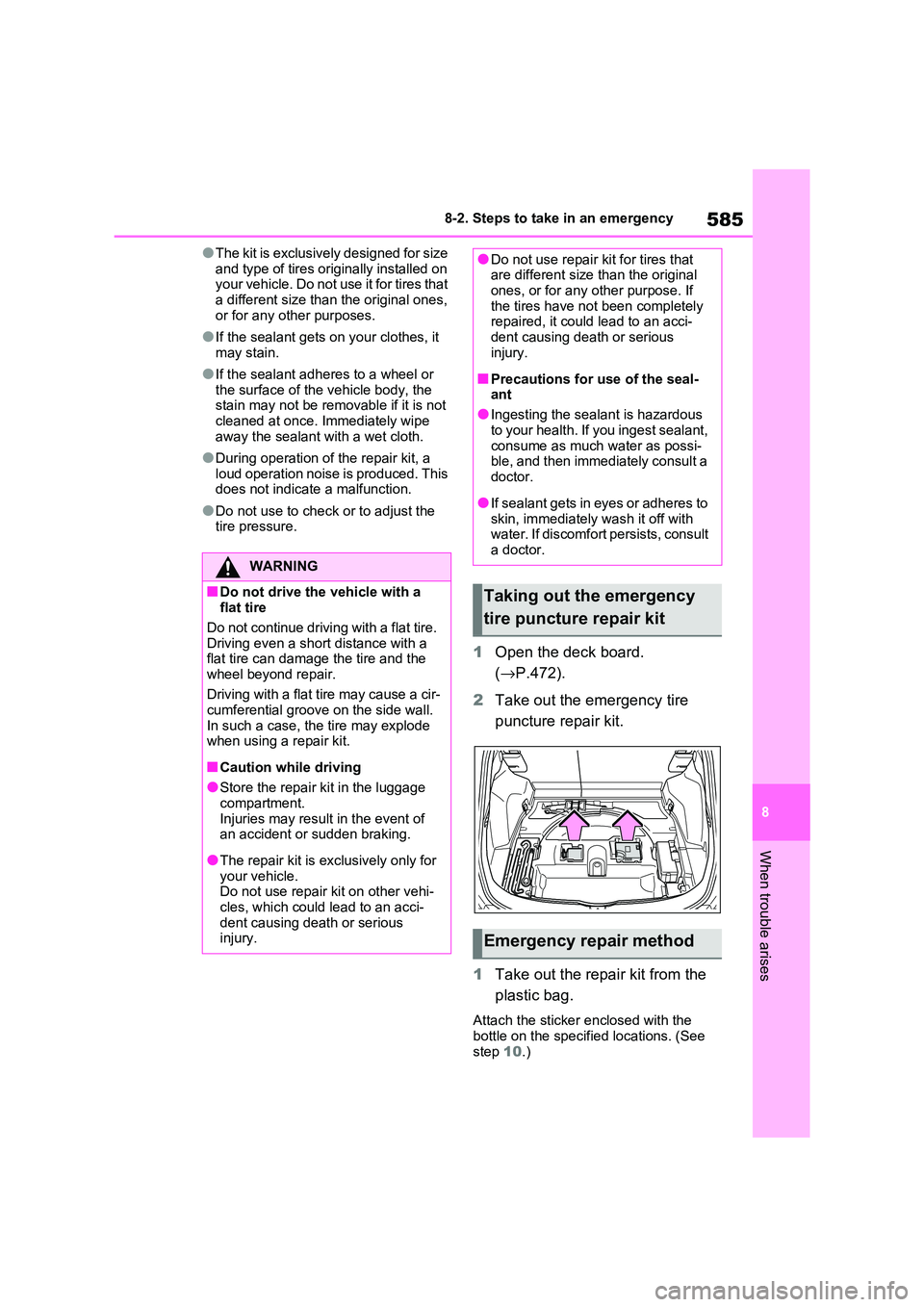
585
8
8-2. Steps to take in an emergency
When trouble arises
●The kit is exclusively designed for size
and type of tires originally installed on your vehicle. Do not use it for tires that
a different size than the original ones,
or for any other purposes.
●If the sealant gets on your clothes, it
may stain.
●If the sealant adheres to a wheel or
the surface of the vehicle body, the stain may not be remo vable if it is not
cleaned at once. Immediately wipe
away the sealant with a wet cloth.
●During operation of the repair kit, a
loud operation noise is produced. This does not indicate a malfunction.
●Do not use to check or to adjust the tire pressure.
1 Open the deck board.
( →P.472).
2 Take out the emergency tire
puncture repair kit.
1 Take out the repair kit from the
plastic bag.
Attach the sticker enclosed with the
bottle on the specified locations. (See step 10.)
WARNING
■Do not drive the vehicle with a
flat tire
Do not continue driving with a flat tire. Driving even a shor t distance with a
flat tire c an damage the tire and the
wheel beyond repair.
Driving with a flat tire may cause a cir -
cumferential groove on the side wall.
In such a case, the tire may explode when using a repair kit.
■Caution while driving
●Store the repair k it in the luggage
compartment.
Injuries may result in the event of an accident or sudden braking.
●The repair kit is e xclusively only for your vehicle.
Do not use repair kit on other vehi -
cles, which could lead to an acci - dent causing death or serious
injury.
●Do not use repair kit for tires that are different size than the original
ones, or for any other purpose. If
the tires have not been completely repaired, it could lead to an acci -
dent causing death or serious
injury.
■Precautions for use of the seal -
ant
●Ingesting the seal ant is hazardous
to your health. If you ingest sealant,
consume as much water as possi - ble, and then immediately consult a
doctor.
●If sealant gets in eyes or adheres to
skin, immediately wash it off with
water. If discomfort persists, consult a doctor.
Taking out the emergency
tire puncture repair kit
Emergency repair method
Page 589 of 666
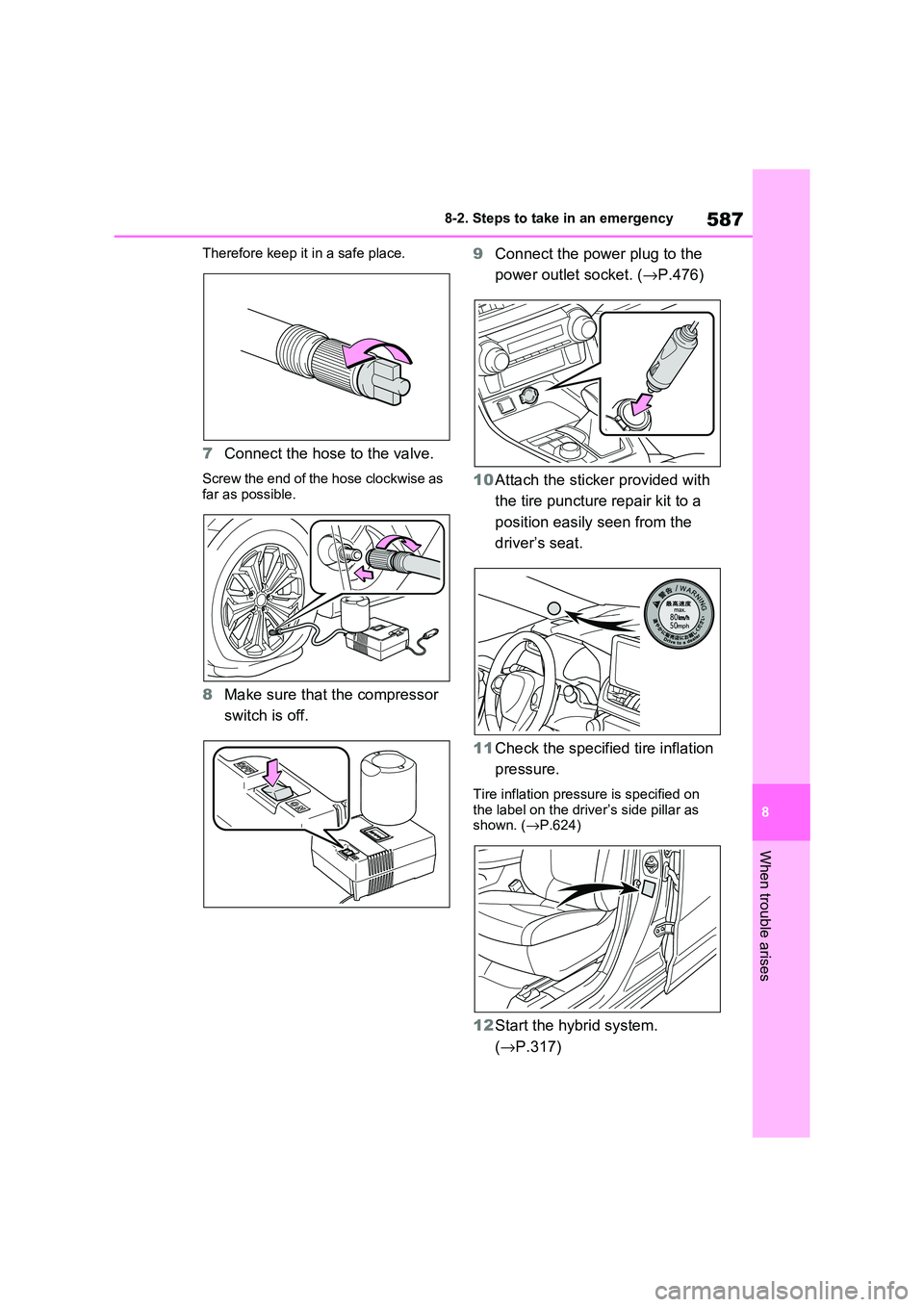
587
8
8-2. Steps to take in an emergency
When trouble arises
Therefore keep it in a safe place.
7 Connect the hose to the valve.
Screw the end of the hose clockwise as
far as possible.
8 Make sure that the compressor
switch is off.
9 Connect the power plug to the
power outlet socket. ( →P.476)
10 Attach the sticker provided with
the tire puncture repair kit to a
position easily seen from the
driver’s seat.
11 Check the specified tire inflation
pressure.
Tire inflation pressu re is specified on
the label on the driv er’s side pillar as
shown. ( →P.624)
12Start the hybrid system.
( →P.317)
Page 590 of 666

5888-2. Steps to take in an emergency
13To inject the sealant and inflate
the tire, turn th e compressor
switch on.
14 Inflate the tire until the specified
air pressure is reached.
The sealant will be injected and
the pressure will spike to
between 300 kPa (3.0 kgf/cm2
or bar, 44 psi) and 400 kPa (4.0
kgf/cm2 or bar, 58 psi), then
gradually decrease.
The air pressure gauge will be
displayed the actual tire inflation
pressure about 1 to 5 minutes
after the switch is turned on.
Turn the compressor switch off and
then check the tire i nflation pressure.
Being careful not to over inflate, check
and repeat the inflat ion procedure until
the specified tire inf lation pressure is
reached.
The tire can be inflated for about 5 to 20
minutes (depending on the outside tem -
perature). If the tire inflation pressure is
still lower than the specified point after
inflation for 25 minutes, the tire is too
damaged to be repaired. Turn the com -
pressor switch off and contact any
authorized Toyota r etailer or Toyota
authorized repairer, or any reliable
repairer.
If the tire inflation pressure exceeds the
specified air pressure, let out some air
to adjust the tire inflation pressure.
( →P.590, 624)
15With the compressor switch off,
disconnect the hose from the
valve on the tire and then pull
out the power plug from the
power outlet socket.
Some sealant may leak when the hose is removed.
16 Install the valve cap onto the
valve of the emergency repaired
tire.
17 Attach the air release cap to the
end of the hose.
If the air release c ap is not attached, the sealant may leak and the vehicle
A
B
Page 591 of 666
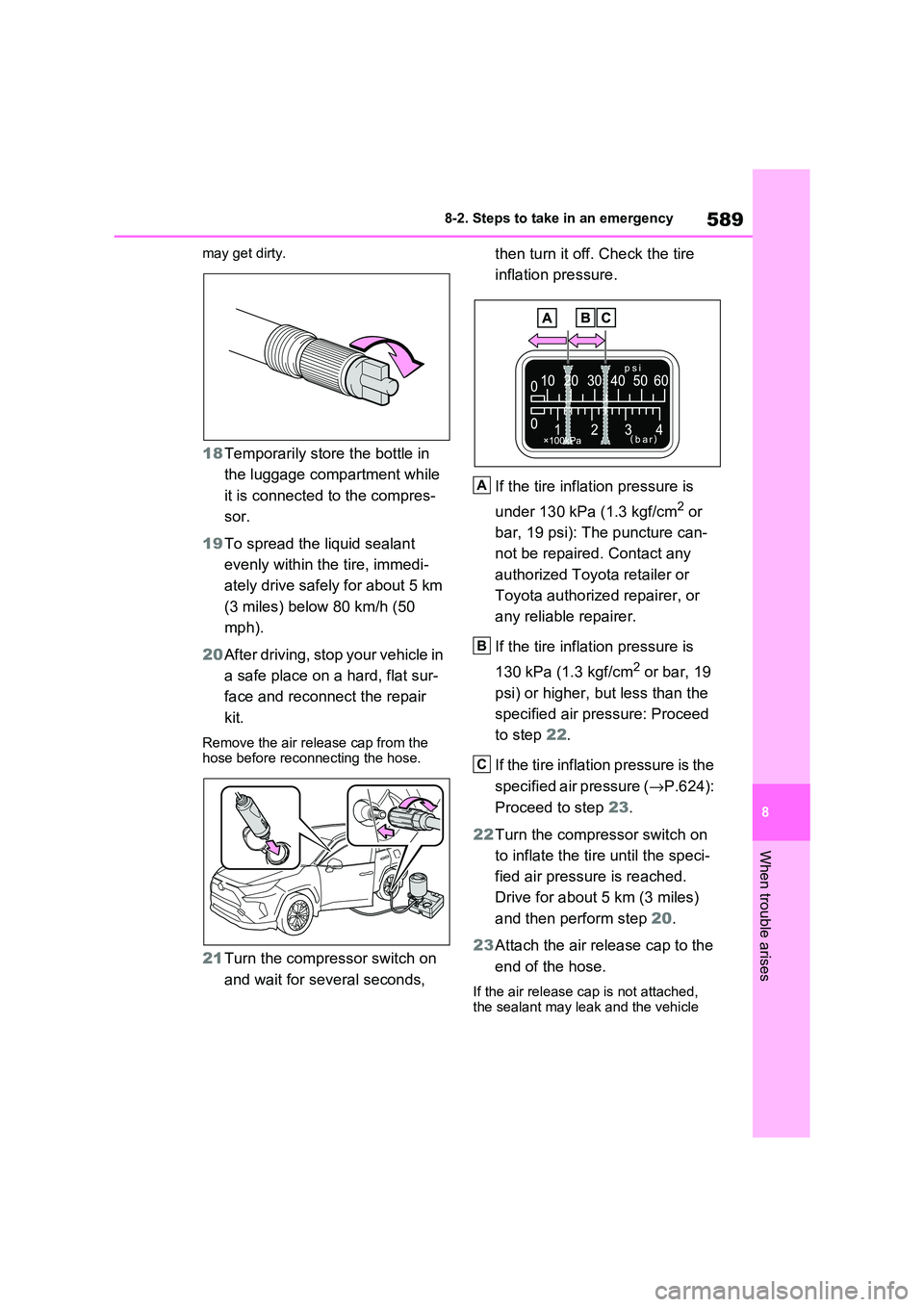
589
8
8-2. Steps to take in an emergency
When trouble arises
may get dirty.
18 Temporarily store the bottle in
the luggage compartment while
it is connected to the compres -
sor.
19 To spread the liquid sealant
evenly within the tire, immedi -
ately drive safely for about 5 km
(3 miles) below 80 km/h (50
mph).
20 After driving, stop your vehicle in
a safe place on a hard, flat sur-
face and reconnect the repair
kit.
Remove the air rel ease cap from the hose before reconnecting the hose.
21 Turn the compressor switch on
and wait for several seconds,
then turn it off. Check the tire
inflation pressure.
If the tire infla tion pressure is
under 130 kPa (1.3 kgf/cm2 or
bar, 19 psi): The puncture can -
not be repaired . Contact any
authorized Toyota retailer or
Toyota authorized repairer, or
any reliable repairer.
If the tire infla tion pressure is
130 kPa (1.3 kgf/cm2 or bar, 19
psi) or higher, but less than the
specified air pr essure: Proceed
to step 22.
If the tire inflation pressure is the
specified air pressure ( →P.624):
Proceed to step 23.
22 Turn the compressor switch on
to inflate the tire until the speci -
fied air pressure is reached.
Drive for about 5 km (3 miles)
and then perform step 20.
23 Attach the air release cap to the
end of the hose.
If the air release c ap is not attached,
the sealant may leak and the vehicle
A
B
C